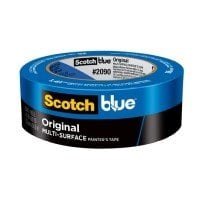Time Saving Tricks for Using Painter's Masking Tape
 Painter's masking tape (also known as blue painters tape) is a very commonly used painting tool that most painters, both amateur and professional, rely on. When you use painter’s masking tape your lines around trim, moldings, doors and windows are crisper and cleaner; also you don’t have to worry as much about mistakes made while painting.
Painter's masking tape (also known as blue painters tape) is a very commonly used painting tool that most painters, both amateur and professional, rely on. When you use painter’s masking tape your lines around trim, moldings, doors and windows are crisper and cleaner; also you don’t have to worry as much about mistakes made while painting.
Whenever you want a straight line, painter's tape will help you get it quickly and effortlessly. It is very important to note that there are some things that painter's tape will help and others that it will not.
Before you mask with painter's tape you must make sure that you are applying it to a clean and dry surface. Be sure to wipe down the area you plan on painting before you begin taping and masking your area. If it is not clean and dry you may have some paint seepage under the tape which makes for an uneven edge.
Buy a good quality painter's tape, such as Scotch brand blue painters tape, because cheaper generic brands tend to crack and pull up paint which will ruin an entire paint job. You will also want to purchase good paint brushes that are recommended for the type of paint you are planning to use. The cheaper brushes or sponge brushes can also cause seepage under the tape.
When you apply the tape, be sure to apply it only a few feet at a time and do not stretch it as you go. Remember that the tape is supposed to be to keep a sharp edge and not for decorative purposes. You can use an old credit card or a putty knife to flatten the tape to the wall.
An easy way to remove the tape is to pull it up and towards you. Do not pull too fast or you will tear the tape. If you go too slowly you can leave adhesive on your surface. You can take the tape off before the paint dries but you don't want to remove it too soon. As a rule of thumb if the paint is dry to the touch you can be sure it is dry enough to take the tape off.
How to Choose Your Painter's Tape
There are many different types of adhesive on different painter's tape. You will want to check the labels because they are also different for different jobs. A good quality painter's type will save you money in the long run.
Normal Blue Painter's tape should not be used on faux, delicate finishes, lacquer or new paint finishes that have been done less than one month. For a situation that requires a less adhesive tape, the Scotch Blue Painter’s tape for Delicate Surfaces is a good choice. Also if you are using latex paints, you will want to remove the tape as soon as the paint is dry. When you are painting across the edge of the tape always make sure that your brush is parallel with the tape as you drag the tip along the surface. You will only have to make one movement across the area.

